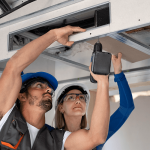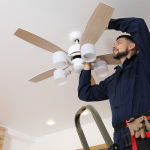Do I Need an Electrician to Replace a Smoke Detector?
Smoke detectors play a pivotal role in ensuring the safety of our homes and businesses. They act as the first line of defence against potential fire hazards, alerting us in the nick of time. However, a common question that many homeowners and business owners grapple with is whether they should replace or install a smoke detector on their own or seek the expertise of a professional.
At Voltfix Electrical, we understand the importance of this decision and its implications for safety. Let’s delve into the nuances of this topic, keeping in mind the specific needs and concerns of businesses.
The Significance of Proper Installation and Replacement
While it might seem like a straightforward task, replacing or installing a smoke detector requires precision and knowledge. A slight misstep can compromise the device’s functionality, leaving you vulnerable to potential dangers.
For businesses, especially, a malfunctioning smoke detector can not only pose a risk to assets and employees but can also lead to significant financial losses in the event of a fire. Hence, ensuring that the device is correctly installed and functioning is paramount.
Workplace Fire Safety: Choosing the Right Smoke Alarm
Smoke alarms are indispensable tools for ensuring safety in any establishment, especially in a workplace setting. With various types available, it becomes imperative to understand their differences and determine which is most suitable for a professional environment. In this section, we will explore the different types of smoke alarms, their advantages and disadvantages, and provide recommendations in line with British standards and regulations.
The Different Types of Smoke Alarms
Ionisation Smoke Alarms:
- How they work: These alarms detect invisible fire particles (associated with fast-flaming fires) using a small amount of radioactive material between two electrically charged plates, which ionises the air and causes a current to flow between the plates. When smoke enters the chamber, it disrupts this flow, triggering the alarm.
- Benefits: They are quick to detect fast-flaming fires.
- Drawbacks: They can be prone to false alarms from burnt toast or steam, making them less ideal for kitchen areas or near bathrooms.
Photoelectric Smoke Alarms:
- How they work: These alarms use a light source and a sensor. When smoke enters the chamber, it scatters the light, which hits the sensor and sets off the alarm.
- Benefits: They are efficient in detecting slow-burning, smouldering fires, which produce a lot of smoke. They are less likely to be triggered by cooking fumes or steam.
- Drawbacks: They might be slightly slower in detecting fast-flaming fires compared to ionisation alarms.
Dual Sensor Smoke Alarms:
- How they work: As the name suggests, these alarms combine the features of both ionisation and photoelectric alarms.
- Benefits: They offer comprehensive fire detection, covering both fast-flaming and slow-burning fires.
- Drawbacks: They can still be prone to false alarms if placed near kitchens or bathrooms due to the ionisation component.
Which Type of Smoke Alarm is Best For the Workplace?
Considering the diverse nature of workplace settings and the British standards and regulations, the following recommendations are made:
- Photoelectric Smoke Alarms: Given their proficiency in detecting smouldering fires and reduced likelihood of false alarms from cooking or steam, these are highly recommended for office spaces, especially those with kitchenettes or near washrooms.
- Dual Sensor Smoke Alarms: For workplaces with varied environments, such as manufacturing units or warehouses, dual sensor alarms provide comprehensive coverage. However, careful placement is essential to avoid areas prone to false alarms.
- Ionisation Smoke Alarms: While they have their merits, due to their sensitivity to fast-flaming fires, they are best suited for areas away from kitchens or bathrooms. They can be considered for isolated sections of a workplace where the risk of fast-flaming fires is higher.
Should I Hire an Electrician For a Fire Alarm Installation?
Fire alarms are a cornerstone of safety in both residential and commercial settings. Their primary function is to alert inhabitants of potential fire threats, allowing for timely evacuation and intervention. Given the critical role they play, the question arises: Should one attempt a DIY installation or entrust this task to a professional electrician? Let’s delve into the intricacies of this decision.
The Disadvantages of DIY Installations
While the allure of saving costs with a DIY approach might be tempting, it comes with its set of challenges:
- Potential Malfunctions: Without the requisite knowledge and expertise, there’s a heightened risk of incorrect installation, leading to potential malfunctions. This can result in the alarm failing to activate during a fire or, conversely, triggering false alarms.
- Safety Hazards: Working with electrical systems, especially for those untrained, can pose significant safety risks. There’s the danger of electrical shocks, incorrect wiring, or even inadvertently creating fire hazards.
- Voiding Warranties: Many fire alarm manufacturers stipulate that their products must be installed by licensed professionals. DIY installations can void these warranties, leaving you without recourse in case of device failures.
The Advantages of Engaging a Professional Electrician
Hiring a professional electrician for fire alarm installation offers several undeniable advantages:
- Expertise: Electricians bring a wealth of experience and knowledge to the table. They are well-acquainted with various fire alarm models and can ensure a seamless installation process.
- Adherence to Safety Standards: Professional electricians are trained to adhere to stringent safety standards. They ensure that the installation is safe, compliant with local regulations, and up to code.
- Optimal Performance Assurance: With a professional installation, you can be confident that your fire alarm will function optimally. Electricians can also provide guidance on the best placement of alarms to ensure maximum coverage and efficacy.
How Does an Electrician Install an Alarm?
The installation of an alarm, be it for fire or security, is a meticulous process that requires precision, expertise, and the right tools. When undertaken by a professional electrician, it ensures that the alarm functions optimally and provides the necessary protection. Let’s walk through the step-by-step procedure that electricians follow during this crucial task.
- Assessment of the Location
Before any actual installation begins, the electrician conducts a thorough assessment of the premises. This involves:
- Identifying the best spots for alarm placement, ensuring maximum coverage.
- Evaluating the existing electrical infrastructure to determine the best way to integrate the alarm system.
- Considering factors like room size, the presence of windows, and potential sources of interference.
- Wiring and Connection
Once the ideal locations are pinpointed, the electrician proceeds with the wiring process:
- Running wires from the main electrical panel to the designated alarm spots. This might involve drilling holes and routing wires through walls, ceilings, or floors.
- Making sure that the connections are secure and that there’s a continuous power supply to the alarm.
- Mounting the Alarm
With the wiring in place, the next step is the actual mounting of the alarm:
- Fixing brackets or mounting plates to the wall or ceiling.
- Attaching the alarm unit to these brackets, ensuring it’s firmly in place and won’t easily be dislodged.
- Testing for Functionality
An essential step post-installation is testing the alarm to ensure it’s working as intended:
- Activating the alarm to check if it sounds off correctly.
- For smoke alarms, simulated smoke might be used to test its detection capability.
- Ensuring that any connected systems, like a central monitoring system, receive the alarm signals.
- Tools and Equipment Used
Professional electricians come equipped with a range of tools to facilitate a smooth installation process:
- Drills and Bits: For making holes in walls, ceilings, or floors to route wires.
- Wire Strippers: To prepare electrical wires for connections.
- Voltage Testers: To ensure there’s no live electricity in wires when working on them.
- Screwdrivers and Pliers: For securing brackets and making connections.
- Ladders: To reach elevated spots for alarm placement.
- Protective Gear: Like gloves and safety goggles to ensure the electrician’s safety during the installation.
The installation of an alarm by a professional electrician is a systematic process that prioritises both functionality and safety. By relying on their expertise, homeowners and businesses can be assured of an alarm system that stands vigilant, offering protection round the clock.
How Do I Know If My Smoke Alarms Are Interconnected?
In the realm of fire safety, interconnected smoke alarms have emerged as a game-changer, offering enhanced protection and early detection. But how can one ascertain if their smoke alarms are interconnected? Let’s delve into the intricacies of interconnected alarms, their benefits, and the tell-tale signs that indicate their presence in your premises.
Understanding Interconnected Smoke Alarms
Interconnected smoke alarms are a network of alarms that communicate with each other. This means that if one alarm detects smoke or fire, all the alarms in the interconnected system will sound off simultaneously. This interconnectedness ensures that no matter where a fire starts, every alarm will alert the inhabitants, providing them with the earliest possible warning.
Signs Your Alarms are Interconnected
- Simultaneous Ringing: The most evident sign of interconnected alarms is when one alarm is triggered, and all other alarms in the premises sound off simultaneously. This coordinated alert ensures that everyone, irrespective of their location, is made aware of the potential danger.
- Labelled as Interconnected: Many smoke alarms come with labels or markings indicating their capability to be interconnected. A quick examination of your alarm might reveal such labels.
- Checking the Wiring: If you’re comfortable with it or with the assistance of an electrician, you can check the wiring of the alarms. Interconnected alarms typically have an additional wire (often coloured red or orange) that facilitates communication between the units.
The Benefits of Interconnected Alarms
- Enhanced Safety: With all alarms sounding off simultaneously, there’s a higher likelihood that everyone in the premises will be alerted promptly, even if the fire starts in a remote corner.
- Early Detection: Fires can spread rapidly. Interconnected alarms ensure that even if a fire starts in an unoccupied room, the entire household or establishment is alerted immediately, allowing for swift action.
- Comprehensive Coverage: Especially in larger homes or commercial spaces, it’s possible that a fire in one area might not immediately trigger alarms in distant sections. Interconnected systems bridge this gap, ensuring that every alarm is activated, and providing comprehensive coverage.
Interconnected smoke alarms are a significant advancement in fire safety, offering a holistic approach to early fire detection. If you’re unsure about the interconnection of your alarms, it’s always advisable to consult with a professional electrician or fire safety expert. Their expertise can not only confirm the interconnection but also provide insights into optimising your fire safety measures.
Smoke Alarms and Safeguarding Spaces
Smoke detectors stand as silent sentinels, guarding our homes and workplaces against the unpredictable and devastating threat of fires. Their pivotal role in ensuring safety cannot be overstated. As we’ve explored, while the allure of self-installation might be tempting, the nuances and intricacies involved underscore the benefits of professional installation.
Choosing a seasoned expert ensures that the installation is precise, compliant with safety standards, and optimally functional. In this context, Voltfix Electrical emerges as a trusted ally. With a commitment to excellence and a reputation for reliability, Voltfix Electrical ensures that your electrical needs, especially those as critical as smoke detectors, are addressed with utmost professionalism.
Take the Next Step with Voltfix Electrical
Smoke detectors are a crucial component of any safety strategy, be it for a home or a business. Ensuring their proper installation and functionality is non-negotiable. If you’re in doubt, it’s always best to err on the side of caution and seek professional assistance.
Are you contemplating replacing or installing a smoke detector? Let Voltfix Electrical be your trusted partner in this endeavour. Reach out to us today, and let’s ensure the safety of your premises together.





